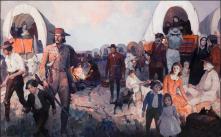Artist Profile
Frank Earle Schoonover
- Lived:
- 1877-1972
- Worked:
- Delaware, Pennsylvania
- Style:
- Illustration
Frank Earle Schoonover was born in Oxford, New Jersey. His father worked in an iron foundry, and the family was not long on culture. He applied to Howard Pyle’s first classes at Drexel and was joyous upon being admitted, stating “I felt honored because his class was a pretty strong one-made up of big shots…Jessie Willcox Smith, Maxfield Parrish, Thornton and Violet Oakley, and others.”
In 1896, he entered Pyle’s classes at Drexel Institute to study illustration rather than the ministry, which his parents had most coveted as his pursuit in life. As a student of Howard Pyle, Frank Schoonover became an ardent adherent of his teacher’s tough belief that an artist should “live what he paints”. After his second year of study, Pyle accepted him into the Chadds Ford summer school on scholarship and by 1899, he was illustrating books such as, A Jersey Boy of the Revolution and In the Hands of the Red Coats.
A few years later, he was illustrating outdoor adventure stories, his fondest desire; In the Open by Mary Raymond Shipman Andrews was the first of a long list of such works. With inspiration from Pyle, in 1903, Schoonover began repeated travel to the Hudson Bay area to experience that environment for use in his illustration works.
Schoonover’s journeys to the Canada and Alaska were more remarkable, when one realizes that in 1903 the artist traveled some 1,200 miles, entirely by snowshoe, canoe and dog sled. Over the years, a great number of his illustrations were based on those daunting excursions, which allowed him to accurately portray the living conditions of these recently settled remote frontiers.
He traveled out West and lived with the Blackfeet Indians, and his depictions of Eskimo’s are as accurate as one can get. ‘To Build A Fire’ from Jack London’s story of the same title, is a perfect example of such a painting. Like Jack London, Schoonover had learned in the wild, what it takes to survive.
Like Pyle and Wyeth, Schoonover’s understanding of the rugged life made him a prime candidate for illustrating classic tales of adventure. Among them: Kidnapped, Robinson Crusoe, Swiss Family Robinson, and Ivanhoe. He also illustrated “the world’s most successful author,” Zane Grey’s serials and novels including Open Range, Avalanche, Rustlers of Silver Ridge, Rogue River Feud, and Valley of Wild Horses.
He illustrated more than two hundred classic books, and with classmate Gayle Hoskins organized the Wilmington Sketch Club in 1925, and formed his own art school in 1942, teaching until he was ninety-one years old.
His earliest commissions came through Howard Pyle and at least once they shared a commission with another fellow Pyle student, Philip R. Goodwin. In 1900, he did a cover for the Saturday Evening Post, with many cover and interior illustration commissions subsequent commissions coming his way for American Girl, Century, Collier’s Weekly, Girl Scouts Magazine, Harper’s, McCall’s Magazine, McClure’s Magazine, Everybody’s Magazine, Frank Leslie’s Monthly, Outing Magazine, Progressive Farmer, Redbook, Sunday Magazine, and Scribner’s Magazine.
In 1905, author Clarence Edward Mulford developed a character with one short leg and called him Hopalong Cassidy or ‘Hoppy’ to his ardent fans. Frank Schoonover found a real life model for the character during his travels and painted that cowboy with a short leg, immortalizing him in the process.
Schoonover and Pyle’s studios in Wilmington were nearby each other for Pyle sometimes hired Schoonover to assist him with a few commissions. Schoonover befriended fellow student, Stanley Arthurs, and in 1906, they traveled to Jamaica with Howard Pyle. That same year Schoonover rented a studio and his neighbors turned out to be more Pyle students; N.C. Wyeth, Henry Jarvis Peck, and Harvey Dunn.
“Schoonover Red” became a signature element in many of Frank’s paintings. He was enamored of the color red and in each of his illustrations he tried, wherever possible, to put in a dash of cadmium red, varnished it more heavily than elsewhere to heighten its intensity and to make it a characteristic symbol of his paintings. It was his attempt at developing a ‘signature’ for marketing his art better.
Frank Schoonover helped to organize what is now the Delaware Museum of Art and was chairman of the fundraising committee charged with acquiring works by Howard Pyle. In his later years he restored paintings including some by Pyle and turned to easel paintings of the Brandywine and Delaware landscapes. He also gave art lessons, established a small art school, designed stain glass windows, and dabbled in science fiction art (illustrating Edgar Rice Burroughs’ A Princess of Mars), he was known locally as the “Dean of Delaware Artists.”
Frank Schoonover died at 94, leaving behind more than two thousand illustrations.
©2004 National Museum of American Illustration,


